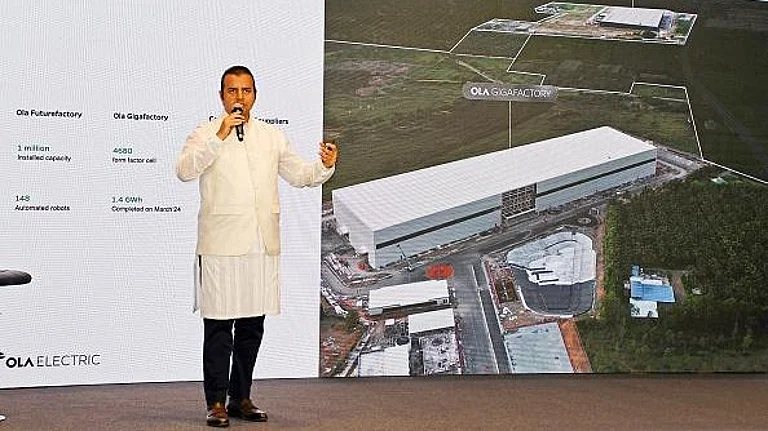
Ola Electric’s market share has dropped sharply from 52% a year ago to 17.35% in July, placing it behind TVS and Bajaj
Founder Bhavish Aggarwal remains confident of regaining 25–30% share with high margins, driven by vertical integration and new launches
The company unveiled its in-house 4680 cell, Gen 3 scooters, and aims to be FCF positive by FY26, despite widening quarterly losses
As Ola Electric faced a steep decline in its market share from 52% to just 20% within few months, founder Bhavish Aggarwal remains bullish about improving it to approximately 30% with “very high margins”, specifically in India’s two-wheeler EV segment.
Aggarwal, in an interview with MoneyControl, stated that Ola Electric is back on the trajectory. He also believes that the market share volumes should begin to climb ahead of the festive season.
“To make money with EVs, you need vertical integration, you need the technology development, you need the DNA of technology. That’s how you will build a good product and make money on it. And that’s where Ola is already,” Aggarwal told the news publication.
He also announced that its in-house 4680 battery cell will power two flagship models: S1 Pro Plus scooter and the Roadster X Plus motorcycle. The deliveries of these two-wheelers will begin during Navaratri, which will kick start on September 22.
It has also unveiled its Gen 3 scooter portfolio earlier this year that boasted of first-in-segment features like brake-by-wire, dual ABS, and variants with its own 4680 cell. Its upcoming sports scooter could include some artificial intelligence features powered by Ola Krutrim.
Ola Electric’s Market Share
In July, TVS Motor secured leadership in the E2W segment with 22,225 registrations, translating to a 21.6% share, though volumes slipped 12.7% month-on-month from 25,468. Bajaj Auto was on the second spot with 19,650 units and a 19.1% share, which reflected a 15.2% drop from June.
Ola Electric’s market share shrank to 17.35% in the same month, securing third position in India’s EV market. However, the company’s market share was 38.83% in the year-ago period. In addition, registrations also reduced to a half to 17,848 units as compared to 41,802 units in July 2024.
Apart from the founder himself, Goldman Sachs had also predicted that Ola Electric could gain market share in the near term with relatively less disruption expected due to rare earth magnets shortage.
The report also noted that Ola Electric’s momentum on in-house technology development - such as its cost-efficient ABS kit - and its vertical integration in cell manufacturing, is expected to drive structural cost advantages and faster go-to-market execution.
It added that the company expects to become free cash flow (FCF) positive by Q4 FY26, with its cell business to follow suit by Q4 FY27.
Ola Electric’s Q1 FY26 Financials
The company’s consolidated net loss increased to ₹428 crore for the quarter ended June 2025. While there is more than 49% fall in revenue (YoY) to ₹828 crore from ₹1,644 crore, the EV maker met its tip-line guidance and witnessed a sequential growth of over 35% from ₹611 crore in the first quarter of FY26.
In addition, the company’s EBITDA margin of auto segment also turned positive in June – for the first time by Ola Electric. It also reported its best gross margin so far, which stood at 25.6%. Ola’s better-than-expected margin performance has been fueled by the demand for its Gen 3 scooters, Roadster bikes, and the high-margin MoveOS+ software.
However, some of its key models have still not received government certification, crucial to unlock PLI-linked incentives. It has also shown improvement in reducing bill-of-materials costs and efficiencies driven by vertical integration, along with proprietary technology.
It has also reduced its auto operating expenses to ₹105 crore per month from ₹178 crore in Q3 FY25, under its cost-cutting program called ‘Lakshya’.
Ola Electric significantly trimmed its Q1 expenses, which dropped 42.4% year-on-year to ₹1,065 crore. This helped narrow consolidated EBITDA losses to ₹237 crore, with the margin improving sharply to -28.6% from -113.9% in the prior quarter. The auto segment also showed progress, with EBITDA improving to -11.6%.































